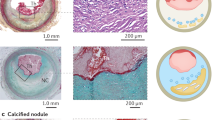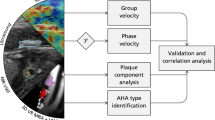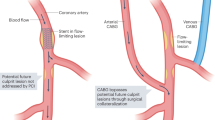Abstract
Sudden cardiac death and acute myocardial infarction often occur as the first manifestation of coronary artery disease. Otherwise asymptomatic individuals with subclinical atherosclerosis almost always have a classic risk-factor profile and it is essential that they are identified before the occurrence of an acute coronary event. The ability to recognize such individuals requires the development of strategies that can localize unstable atherosclerotic lesions. Plaques that are vulnerable to rupture demonstrate distinct histological characteristics, including large plaque and necrotic core volumes, extensive remodeling of the vessel at the lesion site, and attenuated fibrous caps. Precise metrics of typical vulnerable atherosclerotic plaque dimensions will need to be defined to facilitate their identification by noninvasive imaging modalities.
Key Points
-
Atherosclerotic plaque rupture is responsible for two-thirds of all acute coronary events
-
Although plaques vulnerable to rupture are characteristically large and contain big necrotic cores, they may not necessarily impinge on the coronary lumen because of expansive vascular remodeling
-
Unstable plaques are covered by substantially attenuated fibrous caps, and, hence, are called 'thin-cap fibroatheromas'; thin fibrous caps are severely inflamed
-
Proliferation of the vasa vasorum, plaque neovascularization, leakage of red blood cells in plaque, and intraplaque hemorrhage contribute to necrotic core enlargement
-
CT angiography can help identify morphological characteristics of vulnerable plaques, and PET imaging of fluorine-18-labeled fluorodeoxyglucose uptake might enable detection of plaque inflammation
This is a preview of subscription content, access via your institution
Access options
Subscribe to this journal
Receive 12 print issues and online access
$209.00 per year
only $17.42 per issue
Buy this article
- Purchase on Springer Link
- Instant access to full article PDF
Prices may be subject to local taxes which are calculated during checkout




Similar content being viewed by others
References
Narula J and Strauss HW (2007) The popcorn plaques. Nat Med 13: 532–534
Virmani R et al. (2007) The pathology of vulnerable plaque. In The Vulnerable Atherosclerotic Plaques: Strategies for Diagnosis and Management, 21–36 (Eds Virmani R. et al.) Blackwell Publishing: London
Narula J et al. (2005) Picking plaques that pop. J Am Coll Cardiol 45: 1970–1973
Shapiro E et al. (2007) Imaging of vulnerable atherosclerotic plaques. In Atlas of Cardiovascular Computed Tomography, 119–138 (Eds Budoff MJ. et al.) Current Medicine Group: Philadelphia, PA
Ambrose JA et al. (1985) Coronary angiographic morphology in myocardial infarction: a link between the pathogenesis of unstable angina and myocardial infarction. J Am Coll Cardiol 6: 1233–1238
Ambrose JA et al. (1985) Angiographic morphology and the pathogenesis of unstable angina pectoris. J Am Coll Cardiol 5: 609–616
Taylor AJ et al. (1999) Arterial remodeling in the left coronary system: the role of high-density lipoprotein cholesterol. J Am Coll Cardiol 34: 760–767
Kolodgie FD et al. (2007) Elimination of neoangiogenesis for plaque stabilization: is there a role for local drug therapy. J Am Coll Cardiol 49: 2093–2101
Kolodgie FD et al. (2003) Intraplaque hemorrhage and progression of coronary atheroma. N Engl J Med 50: 2316–2325
Motoyama S et al. (2007) Multislice computed tomographic characteristics of coronary lesions in acute coronary syndromes. J Am Coll Cardiol 50: 319–326
Motoyama S et al. (2007) Computed tomography characteristics of atherosclerotic plaques subsequently resulting in acute coronary syndrome. Circulation 116: II–1636
Fuster V (2005) The evolving role of CT and MRI in atherothrombotic evaluation and management. Nat Clin Pract Cardiovasc Med 2: 323
Yuan C (2008) Carotid atherosclerosis and magnetic resonance imaging. J Am Coll Cardiol Imag 1: 58–60
Raman SV et al. (2008) In vivo atherosclerotic plaque characterization using magnetic susceptibility distinguishes symptom-producing plaques. J Am Coll Cardiol Imag 1: 49–57
Feinstein SB (2006) Contrast ultrasound imaging of the carotid artery vasa vasorum and atherosclerotic plaque neovascularization. J Am Coll Cardiol 48: 236–243
Vannan MA et al. (2007) Ultrasonic detection of coronary disease. In The Vulnerable Atherosclerotic Plaque: Strategies for Diagnosis and Management, 211–221 (Eds Virmani R. et al.) Blackwell Publishing: London
Villanueva FS et al. (2004) Targeted ultrasound imaging using microbubbles. Cardiol Clin 22: 283–298, vii
Davies JR et al. (2006) Radionuclide imaging for the detection of inflammation in vulnerable plaques. J Am Coll Cardiol 47: C57–C68
Rogers IS et al. (2007) Assessment of coronary segment inflammation with combined 18-FDG positron emission tomography and 64-slice multidetector computed tomography. Circulation 116: II–410
Kietselaer BL et al. (2004) Noninvasive detection of plaque instability with use of radiolabeled annexin A5 in patients with carotid-artery atherosclerosis. N Engl J Med 350: 1472–1473
Virmani R et al. (2006) Pathology of the vulnerable plaque. J Am Coll Cardiol 47: C13–C18
Jang IK et al. (2005) In vivo characterization of coronary atherosclerotic plaque by use of optical coherence tomography. Circulation 111: 1551–1555
Virmani R et al. (2002) Vulnerable plaque: the pathology of unstable coronary lesions. J Interv Cardiol 15: 439–446
Cheruvu PK et al. (2007) Frequency and distribution of thin-cap fibroatheroma and ruptured plaques in human coronary arteries: a pathologic study. J Am Coll Cardiol 50: 940–949
Ehara S et al. (2004) Spotty calcification typifies the culprit plaque in patients with acute myocardial infarction: an intravascular ultrasound study. Circulation 110: 3424–3429
Yamagishi M et al. (2000) Morphology of vulnerable coronary plaque: insights from follow-up of patients examined by intravascular ultrasound before an acute coronary syndrome. J Am Coll Cardiol 35: 106–111
Hoffmann U et al. (2006) Noninvasive assessment of plaque morphology and composition in culprit and stable lesions in acute coronary syndrome and stable lesions in stable angina by multidetector computed tomography. J Am Coll Cardiol 47: 1655–1662
Burke AP et al. (2003) 34th Bethesda Conference: Task force #2—what is the pathologic basis for new atherosclerosis imaging techniques. J Am Coll Cardiol 41: 1874–1886
Nakamura M et al. (2001) Impact of coronary artery remodeling on clinical presentation of coronary artery disease: an intravascular ultrasound study. J Am Coll Cardiol 37: 63–69
Virmani R et al. (2005) Atherosclerotic plaque progression and vulnerability to rupture angiogenesis as a source of intraplaque hemorrhage. Arterioscler Thromb Vasc Biol 25: 2054–2061
Takaya N et al. (2005) Presence of intraplaque hemorrhage stimulates progression of carotid atherosclerotic plaques: a high-resolution magnetic resonance imaging study. Circulation 111: 2768–2775
Villanueva FS et al. (2007) Myocardial ischemic memory imaging with molecular echocardiography. Circulation 115: 345–352
Hartung D et al. (2007) Radiolabeled Monocyte Chemotactic Protein 1 for the detection of inflammation in experimental atherosclerosis. J Nucl Med 48: 1816–1821
Villanueva FS et al. (1998) Microbubbles targeted to intercellular adhesion molecule-1 bind to activated coronary artery endothelial cells. Circulation 98: 1–5
Tsimikas S and Shaw PX (2002) Non-invasive imaging of vulnerable plaques by molecular targeting of oxidized LDL with tagged oxidation-specific antibodies. J Cell Biochem Suppl 39: 138–146
Fischman AJ et al. (1989) Radionuclide imaging of experimental atherosclerosis with nonspecific polyclonal immunoglobulin G. J Nucl Med 30: 1095–1100
Schmitz SA et al. (2000) Superparamagnetic iron oxide-enhanced MRI of atherosclerotic plaques in Watanabe hereditable hyperlipidemic rabbits. Invest Radiol 35: 460–471
Isobe M et al. (1992) Imaging the rejecting heart: in vivo detection of major histocompatibility complex class II antigen induction. Circulation 85: 738–746
Kolodgie FD et al. (2003) Targeting of apoptotic macrophages and experimental atheroma with radiolabeled annexin V: a technique with potential for noninvasive imaging of vulnerable plaque. Circulation 108: 3134–3139
Gupta S et al. (2005) Mortals turn me on... J Nucl Med 46: 906–908
Fujimoto S et al. (2007) Molecular imaging of matrix metalloproteinase in atherosclerotic lesions: resolution with dietary modification and statin therapy. Circulation 116: II–560
Oshima S et al. (2007) Imaging of vasa vasorum in atherosclerotic plaque with 99mTc-labeled single chain-VEGF. Circulation 116: II–230
Author information
Authors and Affiliations
Corresponding author
Ethics declarations
Competing interests
The authors declare no competing financial interests.
Supplementary information
Supplementary tables
Morphologic characteristics of vulnerable plaques. (DOC 248 kb)
Rights and permissions
About this article
Cite this article
Narula, J., Garg, P., Achenbach, S. et al. Arithmetic of vulnerable plaques for noninvasive imaging. Nat Rev Cardiol 5 (Suppl 2), S2–S10 (2008). https://doi.org/10.1038/ncpcardio1247
Received:
Accepted:
Issue Date:
DOI: https://doi.org/10.1038/ncpcardio1247
This article is cited by
-
Modelling systemic risk factors in cardiovascular disease using single-cell biology
Nature Cardiovascular Research (2023)
-
The Presence of Residual Vascular and Adipose Tissue Inflammation on 18F-FDG PET in Patients with Chronic Coronary Artery Disease
Nuclear Medicine and Molecular Imaging (2023)
-
Postmortem coronary artery calcium score in cases of myocardial infarction
International Journal of Legal Medicine (2021)
-
CCTA in the diagnosis of coronary artery disease
La radiologia medica (2020)
-
Imaging the event-prone coronary artery plaque
Journal of Nuclear Cardiology (2019)



